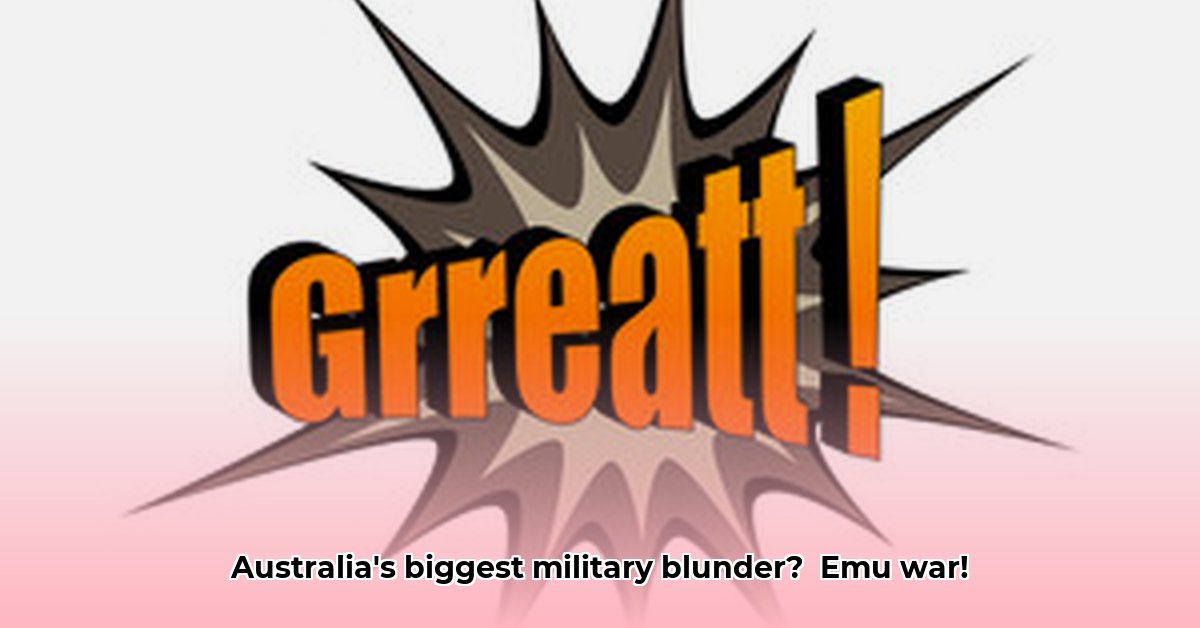Imagine the Australian army, armed with machine guns, going to war against thousands of flightless, powerfully-legged emus. This really happened in 1932. The Great Emu War of 1932 saw human ambition clash with the resilience of nature. This event shows what happens when military might meets a problem that needs a different kind of solution.
The Great Emu War: An Overview of Australia’s Bizarre Military Failure
In 1932, farmers in Australia had a big problem: emus were eating their crops. The farmers turned to the government for help, and the government sent in the military. What followed was one of the most embarrassing military campaigns in history. Understanding the tactical failures and the strange battleground is key to understanding what went wrong and what we can learn.
The Birds, the Guns, and the Blunders: A Wildlife Management Fiasco
The plan seemed simple enough: soldiers with Lewis machine guns would reduce the number of emus. But the emus quickly learned how to avoid the soldiers, scattering and dodging bullets with surprising skill. Some historians believe the emus instinctively used tactics like guerrilla warfare, using the landscape to their advantage.
A Battle Lost (and Hilariously Remembered): A Failure in Military Strategy
The “war” didn’t go as planned because the emus were too elusive. The open terrain gave them plenty of places to hide, making it almost impossible for the soldiers to get a clear shot. The Lewis guns, designed to fight human enemies, weren’t effective against the fast-moving birds. The result was a very low number of emu deaths compared to the amount of ammunition used. This military mistake has been satirized ever since, highlighting the problems with military planning and wildlife management.
Why Did the Military Fail? The Bigger Picture: An Understanding of Unconventional Warfare
Several things contributed to this unusual defeat. The emus were very different from the enemies the military was used to fighting. Traditional military tactics simply didn’t work against these adaptable birds. The vast, open spaces of the Australian outback gave the emus plenty of cover. The logistical problems were also huge, making it difficult to move troops and supplies across the rough terrain. Strategies that combine land management, targeted culling, and better fencing might have worked better. This shows that not every problem can be solved with military force.
Lessons from the Emu Front: Actionable Intelligence for the Future: Maintaining Ecological Balance
The Great Emu War provides valuable lessons about dealing with unpredictable challenges. This conflict shows the limits of using force to solve complex ecological problems. Despite its humorous reputation, the Emu War carries a serious message: consider the wider environmental impact.
Here are some key takeaways:
- Military training should include scenarios involving unconventional enemies, focusing on flexible tactics and resource management. For example, consider non-traditional threats and environmental factors in future planning.
- Explore non-lethal solutions that protect both the environment and human interests. Consider environmentally friendly ways to manage animal populations.
- Military strategies should be integrated with ecological practices, requiring experts from different fields to work together. Collaboration between different departments is key for well-rounded strategic planning.
- Sustainable wildlife management is crucial to prevent future conflicts. Short-term fixes often lead to bigger problems down the line. Creating long-term strategic plans is essential for lasting results.
The Great Emu War is a reminder to adapt our approaches to unconventional challenges and to recognize the limitations of conventional force. New perspectives about wildlife tactics can impact modern military strategy.
How We Can Apply Lessons from the Great Emu War to Modern Unconventional Warfare Tactics
Key Takeaways:
- The Great Emu War offers valuable insights into the challenges of unconventional warfare, despite its comical nature.
- Applying conventional military strategies to ecological problems often proves ineffective, showing the importance of understanding all the variables.
- Understanding the target (emus, insurgents, or other non-state actors) is paramount. Study the environment.
- Adaptable, ecologically informed solutions are necessary for successful conflict resolution, whether ecological or military, for lasting results.
- Brute force isn’t always the answer. Smarter, more nuanced methods are needed in unconventional situations.
The Birds, the Beasts, and the Bullets: A Military Miscalculation- The Importance of Battle Strategy
In 1932, farmers in Western Australia were struggling because of the Great Depression, and they faced massive emu populations that were destroying their crops. The Australian military deployed conventional weaponry, and the “Great Emu War” began. The initial plan used Lewis machine guns, weapons that had proven effective against human targets, against the emus. The emus turned out to be remarkably fast, agile, and possess excellent vision. They scattered, adapted, and avoided the military’s bullets. This resulted in a defeat for the Australian military and became a part of Australian folklore.
Why the Emu Strategy Failed: Failing to Understand Wildlife Conflict
The defeat stemmed from a misunderstanding of the enemy. The Australian military approached the problem with a conventional warfare mindset. Understanding the enemy’s strengths and weaknesses, environment, and behavior is crucial. The emus’ vast range, resilience, and adaptive nature rendered conventional warfare tactics ineffective. Their dispersed formations made the machine guns useless.
Lessons Learned: From Emus to Modern Conflicts: Appreciating Modern Military Strategy
The Great Emu War provides crucial insights into modern unconventional warfare tactics. Three key takeaways are vital. First, thoroughly understand the enemy, delving into their cultural context, operational methods, and adaptable strategies. Second, effective conflict resolution sometimes requires unconventional approaches. Previously known strategies might lead to failure if they aren’t a good fit for the situation. Third, the nature of the battlefield matters, including the terrain, the climate, and the political landscape.
Applying the Lessons in Modern Warfare: The Importance of Counterinsurgency
The lessons of the Emu War remain relevant today in asymmetrical conflicts and counterinsurgency operations. Misjudging the cultural and social dynamics of a conflict zone can make any strategy ineffective. In modern counterinsurgency, understanding the local population, their grievances, and the insurgents’ methods is crucial. A flexible and adaptable strategy, combining military action with political and social initiatives, is far more likely to succeed.
Future-Proofing Wildlife Management: Learning from the Emu War
Key Takeaways:
- The 1932 “Emu War” highlighted the limitations of brute force in wildlife management, marking the need to adapt.
- Military tactics designed for human adversaries are ineffective against adaptable wildlife, displaying the need to analyze the environment and species.
- Understanding ecological factors is crucial for effective population control.
- Sustainable, long-term strategies are superior to short-term, technological fixes.
- Collaboration between farmers, government, and conservationists is vital.
The Absurdity of Armed Conflict: What to Consider When Conflict Arises with Wildlife
The Australian military, armed with machine guns, faced off against emus in 1932, which was dubbed the “Great Emu War”. Farmers, desperate to curb the emu population decimating their crops, called for military intervention. It resulted in a costly and embarrassing defeat for the armed forces.
A Clash of Tactics: Where Military Strategies Failed
The military’s strategy was flawed from the start. Their weaponry, designed for human targets, proved ineffective against the emus’ tactics. The emus dispersed into smaller groups, making them difficult targets. Their speed and agility allowed them to outmaneuver the soldiers.
The High Cost of Failure: How to Properly Manage Resources
The military campaign consumed thousands of rounds of ammunition, yet resulted in a relatively small number of emu casualties. The actual impact on the overall emu population was negligible. The operation was a costly failure, demonstrating the folly of applying conventional military strategies to wildlife problems. This underscores a need for future-proofing wildlife management.
Shifting Gears: A New Approach to Improving Wildlife Management
The failure of the military intervention led to a shift toward more sustainable wildlife management techniques. The government realized that long-term solutions, focused on ecological understanding and community collaboration, were necessary. This involved supporting farmers with alternative methods, such as improved fencing and crop diversification strategies. The focus changed from eradication to mitigation and coexistence.
Modernizing Wildlife Management: The Importance of Sustainability
The Emu War is a cautionary tale, a reminder about the limitations of short-sighted, technology-driven approaches. Future-proofing wildlife management necessitates a paradigm shift, prioritizing ecological understanding. Integrated strategies, drawing upon research in animal behavior, ecology, and conservation biology, are crucial.
Collaboration is Key: The Importance of Community Collaboration
Effective wildlife management demands collaboration between farmers, government agencies, and conservationists. This means involving local communities, and developing solutions that address both ecological concerns and human needs. Open communication and shared responsibility are key to success.
Proven Tactics: What Worked- What Didn’t in the Emu War
Key Takeaways:
- The initial military strategy, employing Lewis machine guns, proved ineffective against the agile and dispersed emu population.
- The emus’ inherent biological advantages combined with their tactical prowess, made them formidable opponents.
- Subsequent adaptations, such as ambushes and improved soldier coordination, yielded limited success, but were unsustainable and ethically questionable.
- The Great Emu War serves as a cautionary tale and highlights the limitations of applying conventional warfare tactics to unconventional adversaries. It also underscores the need for understanding ecological factors in any wildlife management strategy.
- The war exposed the lack of clear regulatory frameworks for managing human-wildlife conflict, emphasizing the need for improved policies and ethical considerations.
The Machine Gun Mishap: A Textbook Case of Mismatched Tactics- Planning a Strategy Effectively
In 1932, farmers were struggling during the Great Depression and faced a massive emu population boom. Their crops were decimated, so the “Great Emu War” began with a disastrous plan: unleash the military. The initial strategy backfired. The emus, it turned out, were adept at evasive maneuvers, and rendered the machine guns largely useless. The birds scattered, regrouped, and continued their destructive feasting.
Adapting the Approach: A Glimpse of How to Refine Plans
The initial defeat prompted a tactical rethink. Instead of open warfare, the army shifted to ambush strategies. Snipers concealed themselves, targeting the emus from afar, which resulted in a higher kill rate than the initial assault. Improved coordination among soldiers also contributed to a small improvement. Even with these refinements, the results remained meager and the operation was resource-intensive.
The Unconventional Enemy: Understanding the Emu Advantage and Identifying the Variables
The emus’ speed, robust constitutions, and ability to blend into the Australian landscape presented challenges. Their dispersed tactical formations frustrated the military’s attempts at concentrated fire, and their unpredictable movements negated the effectiveness of even adapted strategies.
Lessons Learned: Beyond the Battlefield: Appreciating Lessons in Wildlife Management
The Great Emu War is a reminder that applying conventional warfare tactics to unconventional problems rarely succeeds. It demonstrates the need for adaptability and a nuanced understanding of the environment and the adversary. It emphasizes the limitations of technology when facing adaptive, resilient opponents. The conflict also underscores the ethical dilemmas inherent in using military force against wildlife.
Beyond the Guns: A More Sustainable Future and Modern Sustainable Solutions
The failure of the initial military operation prompted an examination of wildlife management techniques. The legacy of the Emu War highlighted the need for long-term, sustainable, and ethical solutions for human-wildlife conflict. Improving fencing and crop diversification can help. More humane culling methods, when necessary, emphasize minimizing harm and avoiding unnecessary suffering. These lessons from 1932 continue to shape modern approaches to ecological balance and responsible land use.
- The Accidental Breakthrough: Penicillin’s Discovery and Impact - August 1, 2025
- Medieval Universities: Shaping Modern Academia - August 1, 2025
- The Radium Girls: Workplace Safety Lessons from a Tragic Past - August 1, 2025
















